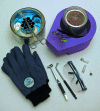Practical macromolecular cryocrystallography
- PMID: 26057787
- PMCID: PMC4461322
- DOI: 10.1107/S2053230X15008304
Practical macromolecular cryocrystallography
Abstract
Cryocrystallography is an indispensable technique that is routinely used for single-crystal X-ray diffraction data collection at temperatures near 100 K, where radiation damage is mitigated. Modern procedures and tools to cryoprotect and rapidly cool macromolecular crystals with a significant solvent fraction to below the glass-transition phase of water are reviewed. Reagents and methods to help prevent the stresses that damage crystals when flash-cooling are described. A method of using isopentane to assess whether cryogenic temperatures have been preserved when dismounting screened crystals is also presented.
Keywords: annealing; automounter; cryocrystallography; cryoprotectant; crystal mounting; flash-cooling; high pressure.
Figures








Similar articles
-
Macromolecular cryocrystallography--methods for cooling and mounting protein crystals at cryogenic temperatures.Methods. 2004 Nov;34(3):415-23. doi: 10.1016/j.ymeth.2004.03.032. Methods. 2004. PMID: 15325658 Review.
-
Macromolecular crystal annealing: overcoming increased mosaicity associated with cryocrystallography.Acta Crystallogr D Biol Crystallogr. 1998 Jul 1;54(Pt 4):622-8. doi: 10.1107/s0907444997019008. Acta Crystallogr D Biol Crystallogr. 1998. PMID: 9761858
-
'Cool' crystals: macromolecular cryocrystallography and radiation damage.Curr Opin Struct Biol. 2003 Oct;13(5):545-51. doi: 10.1016/j.sbi.2003.09.013. Curr Opin Struct Biol. 2003. PMID: 14568608 Review.
-
Cryocrystallography of macromolecules: practice and optimization.Methods Mol Biol. 2007;364:1-18. doi: 10.1385/1-59745-266-1:1. Methods Mol Biol. 2007. PMID: 17172757
-
The role of solvent transport in cryo-annealing of macromolecular crystals.Acta Crystallogr D Biol Crystallogr. 2004 Mar;60(Pt 3):412-21. doi: 10.1107/S0907444903027938. Epub 2004 Feb 25. Acta Crystallogr D Biol Crystallogr. 2004. PMID: 14993664
Cited by
-
Ice formation and its elimination in cryopreservation of oocytes.Sci Rep. 2024 Aug 13;14(1):18809. doi: 10.1038/s41598-024-69528-8. Sci Rep. 2024. PMID: 39138273 Free PMC article.
-
PDBe CCDUtils: an RDKit-based toolkit for handling and analysing small molecules in the Protein Data Bank.J Cheminform. 2023 Dec 2;15(1):117. doi: 10.1186/s13321-023-00786-w. J Cheminform. 2023. PMID: 38042830 Free PMC article.
-
X-ray Scattering Studies of Protein Structural Dynamics.Chem Rev. 2017 Jun 28;117(12):7615-7672. doi: 10.1021/acs.chemrev.6b00790. Epub 2017 May 30. Chem Rev. 2017. PMID: 28558231 Free PMC article. Review.
-
The structure of an iron-containing alcohol dehydrogenase from a hyperthermophilic archaeon in two chemical states.Acta Crystallogr F Struct Biol Commun. 2019 Apr 1;75(Pt 4):217-226. doi: 10.1107/S2053230X19001201. Epub 2019 Mar 13. Acta Crystallogr F Struct Biol Commun. 2019. PMID: 30950821 Free PMC article.
-
Allosteric binding sites in Rab11 for potential drug candidates.PLoS One. 2018 Jun 6;13(6):e0198632. doi: 10.1371/journal.pone.0198632. eCollection 2018. PLoS One. 2018. PMID: 29874286 Free PMC article.
References
-
- Alkire, R. W., Duke, N. E. C. & Rotella, F. J. (2008). Is your cold-stream working for you or against you? An in-depth look at temperature and sample motion. J. Appl. Cryst. 41, 1122–1133.
-
- Alkire, R. W., Rotella, F. J. & Duke, N. E. C. (2013). Testing commercial protein crystallography sample mounting loops for movement in a cold-stream. J. Appl. Cryst. 46, 525–536.
-
- Berejnov, V., Husseini, N. S., Alsaied, O. A. & Thorne, R. E. (2006). Effects of cryoprotectant concentration and cooling rate on vitrification of aqueous solutions. J. Appl. Cryst. 39, 244–251.
Publication types
MeSH terms
Substances
LinkOut - more resources
Full Text Sources
Other Literature Sources

